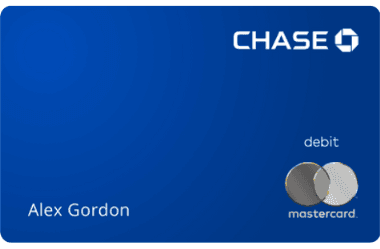Can the new kid on the block Chase rival the poster child of digital banking Monzo? Our guide compares their free account features side by side to help you decide which one might be your best option.
Vital statistics
With the free Monzo current account, you get its well-known coral-coloured card, while Chase’s only (and free) current account comes with a blue numberless card.
Neither bank has branches, with the accounts being fully managed via a mobile app. Chase offers a linked saver account, where current holders can deposit savings on an easy-access basis and earn 4.5% interest AER for the first 12 months. Monzo has a range of savings options, with varying rates depending on whether you pay for an account.
Both Chase and Monzo have a UK banking licence, which means individual customer funds up to the value of £120,000 are protected by the Financial Services Compensation Scheme (FSCS) should a bank go under.
You can apply for an overdraft with Monzo – the interest rate you’re offered will depend on your personal circumstances and credit score – but Chase doesn’t offer any overdrafts yet.
Chase was the winner in Finder’s 2025 Customer Satisfaction Awards, with 100% of customers saying they would recommend the current account. Monzo was not far behind, with a “would recommend” score of 90%.
They both have different cashback offerings. Chase has 1% cashback on grocery, transport and fuel card spend (up to £15 per month) for the first 12 months. After that, customers will have to deposit a minimum of £1,500 a month in order to earn cashback. By contrast, Monzo provides different cashback rates for different retailers and it’s a bit of a lottery as to whether you’ll get something you’ll actually use.
Round 1: App features
With both the app-managed Chase and Monzo accounts, you can set up direct debits, receive your salary and make bank transfers (although with Chase, noticeably not international payments). You can also freeze and unfreeze your debit card and reach the customer service teams through an in-app chat.
Both offer “round-ups”, where you can round up your card transactions to the nearest pound and put that money to one side. Chase keeps this round-up balance separate from your main current account balance and will pay 5% AER on it. After 12 months, your money will be transferred to your current account and you can start rounding up again. With Monzo, this spare change will go into a “savings pot” with no interest earned on it.
Unlike Monzo, Chase has no spending categories, specific budgeting tools or saving pots available.
Monzo also lets you scan in and deposit cheques of up to £500 through the app, while those of greater value can be sent in by post. You can also pay in cash at PayPoints or a Post Office branch for a fee of £1. Chase doesn’t accept cash or cheques into its current accounts.
Winner: Monzo. While Chase has launched its account with a decent range of app features, Monzo’s more established app shines through, particularly when it comes to spending insights and budgeting.
Round 2: Spending in the UK
 |  | |
| Free card transactions in the UK | ||
| Contactless card limit | £100 | £100 |
| Apple Pay | ||
| Google Pay | ||
| Samsung Pay | ||
| Free ATM withdrawals | Up to £500 per day | Up to £400 per month |
| Find out more |
Spending on your Chase or Monzo card is free in the UK, and both cards currently have the standard contactless limit of £100.
You can also add your Chase card or Monzo card to Apple Pay, Samsung Pay and Google Pay.
As mentioned, Chase customers can also earn 1% cashback on certain spending (up to £15 per month). In theory, you could earn more cashback than that with Monzo, but it really depends on whatever cashback deals it is offering at any given time.
Chase offers unlimited free ATM withdrawals in the UK, while Monzo lets you withdraw up to £400 for free every 30 days in either the UK or EEA (it’s a combined limit), then there’s a 3% charge. However, if you use Monzo as your main bank account, you can make unlimited fee-free withdrawals in the UK and EEA.
Winner: Chase. The bank edges it with its free UK ATM withdrawals, plus its cashback offer is simpler.
Round 3: Using the card abroad
 |  | |
| Free foreign transactions | Unlimited | Unlimited |
| Free foreign ATM withdrawals | Up to £1,500 per month | Up to £400 in EEA and £200 elsewhere every 30 days |
| Find out more |
Chase and Monzo are the same when it comes to using their respective cards to make purchases abroad – neither charges a fee. Plus they both use the competitive Mastercard exchange rate for foreign transactions.
When travelling with your Monzo card, there’s a £200 limit on free cash withdrawals overseas every 30 days – after which there’s a 3% charge. And if you’re in Europe, then the combined UK and EEA monthly free limit of £400 applies, before the 3% fee kicks in – unless you use Monzo as your main bank account, in which case there’s no limit.
Chase doesn’t have fees for making ATM withdrawals anywhere overseas, but it does have a monthly withdrawal limit of £1,500 (and that’s a total cut-off point, rather than a fee applying to amounts over that). The daily withdrawal limit within that £1,500 monthly limit is an industry-generous £500 per day.
Winner: Chase. For its fee-free card purchases and ATM withdrawals overseas (although the £1,500 per month cut-off limit may prove troublesome for some account holders on longer trips abroad).
Round 4: Account types
 |  | |
| Free account | ||
| Premium account | ||
| Joint account | ||
| Teen account (for 16- and 17-year olds) | ||
| Kids' account or card | ||
| Business account | ||
| Find out more |
Both Chase and Monzo offer free current accounts (which are the subjects of this guide), but that’s where it ends for new entrant Chase (apart from the linked saver account mentioned above).
Monzo also has joint accounts, business accounts and teen accounts (for 16- and 17-year-olds) on its roster. It also launched a kids’ account in 2025.
Winner: Monzo. No contest on this front.
Round 5: Signing up
 |  | |
| Apply through the app | ||
| Quick application | ||
| Credit check | ||
| Card delivery fee | Free | Free |
| Card delivery timescale | 5-7 working days | 2-7 working days |
| Find out more |
You can apply for either a Chase or Monzo account through their respective mobile apps in a matter of minutes, with no hard credit checks.
The banks’ cards are free to receive, and they should arrive within 7 working days.
Winner: A tie. The sign-up process is similarly easy for both.
Round 6: Customer reviews
On reviews site Trustpilot, Chase has a score of 3.7 out of 5 from over 13,900 reviews. Monzo has a score of 4.6 out of 5 from more than 57,000 reviews. These were checked in September 2025.
Reviews praised Chase for its ease of use, but some complained that the deposit required to earn ongoing cashback is too high. Monzo customers also liked its ease of use but some voiced frustration with customer service.
In our 2025 Customer Satisfaction Awards, Chase was recommended by 100% of those surveyed, with a score of 4.3 out of 5. Monzo also scored 4.4 out of 5 and was recommended by 90% of those surveyed.
Winner: Tie. There’s not much to separate the pair here.
Overall winner: Is Chase better than Monzo?
New entrant Chase is certainly gaining a lot of attention. Although the bank is a massive player in the American banking market, it hasn’t quite brought all of its account features to the UK yet. For that reason, if you want a fully rounded current account with a well-designed and engaging app, then you’d probably be better off going for Monzo. But what is tempting from Chase are some of the financial offers with its current account – namely the linked 4.5% AER saver account, 1% on current account balances, 1% cashback on card spend and interest on round-up balances. If any of those catch your eye, and they outweigh the more advanced features of Monzo for you, then maybe Chase is the way to go.
Sources
More guides on Finder
-
Monzo Max review: Is the account worth it?
Is the Monzo Max account worth applying for?
-
Is Monzo Perks worth it?
Are Monzo Perks, Monzo Max and Monzo Extra worth the money? See our analysis in this video review.
-
Best online-only banks in the UK
Online-only banks have some limitations, but they also tend to offer handy features that might convince you to switch.
-
How to withdraw cash from an ATM without your debit card
If you’ve forgotten or misplaced your bank card and need to take out cash, several options are available. From where to get cashback to what you need to take to a branch, here’s what you need to know.
-
How to get a prepaid debit card without ID
Prepaid cards are a good option for people who don’t have any traditional forms of ID. Discover what you could use instead.
-
BuildMyCreditScore review
Discover more about how BuildMyCreditScore works, which banks it connects to and how long it will take to improve your credit score.
-
Banks that allow you to pay cheques in online
Discover which banks let you pay in cheques online and how to do it.
-
Advantages and disadvantages of an overdraft
Find out more about the pros and cons of an overdraft.
-
Santander Edge Up review
Level up your cashback earning potential with the Santander Edge Up current account. Find out about its features and benefits in our review.
-
Monzo bank account and card review
Is Monzo’s app-only current account the right option for you? Read our review to get the low-down on all of the features of the account, its card and the app.



